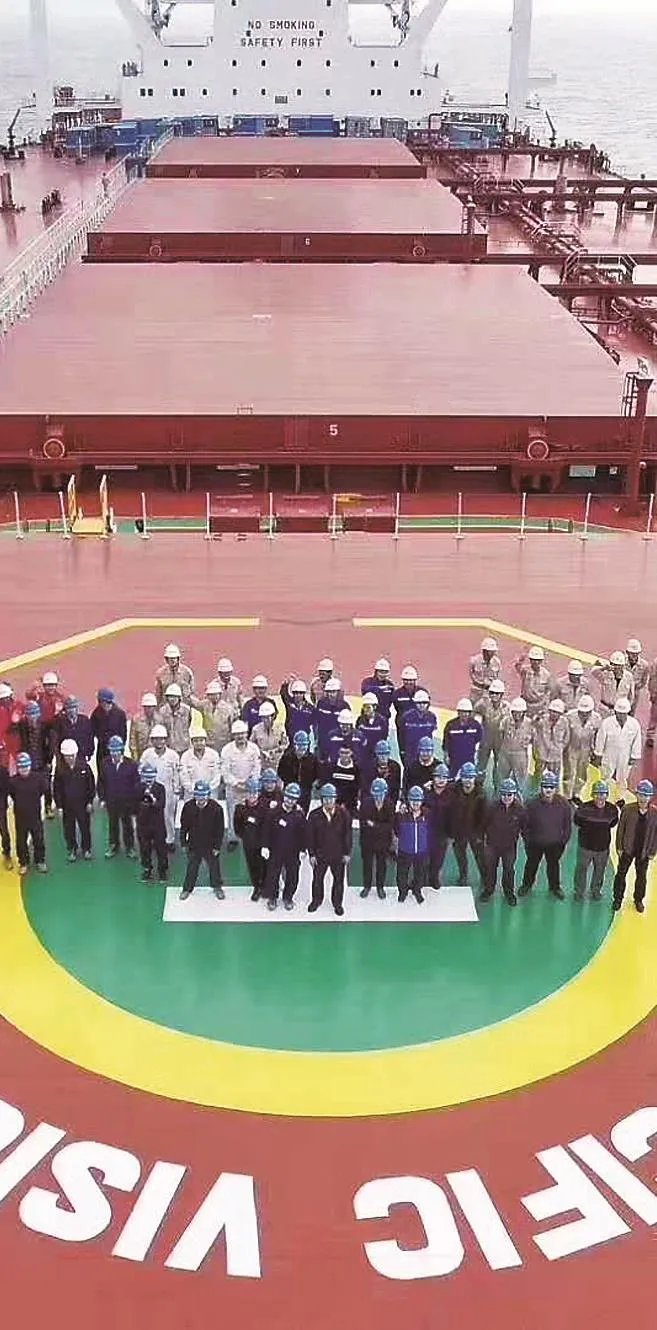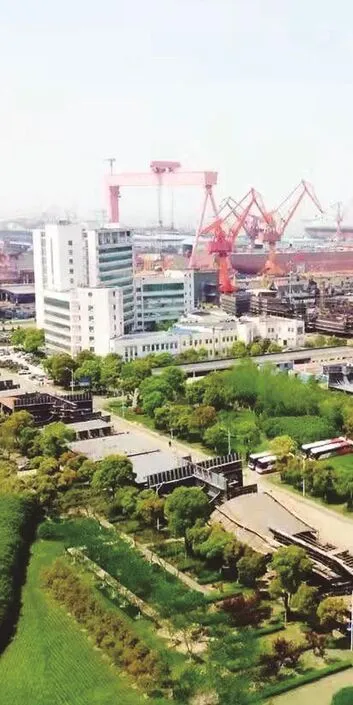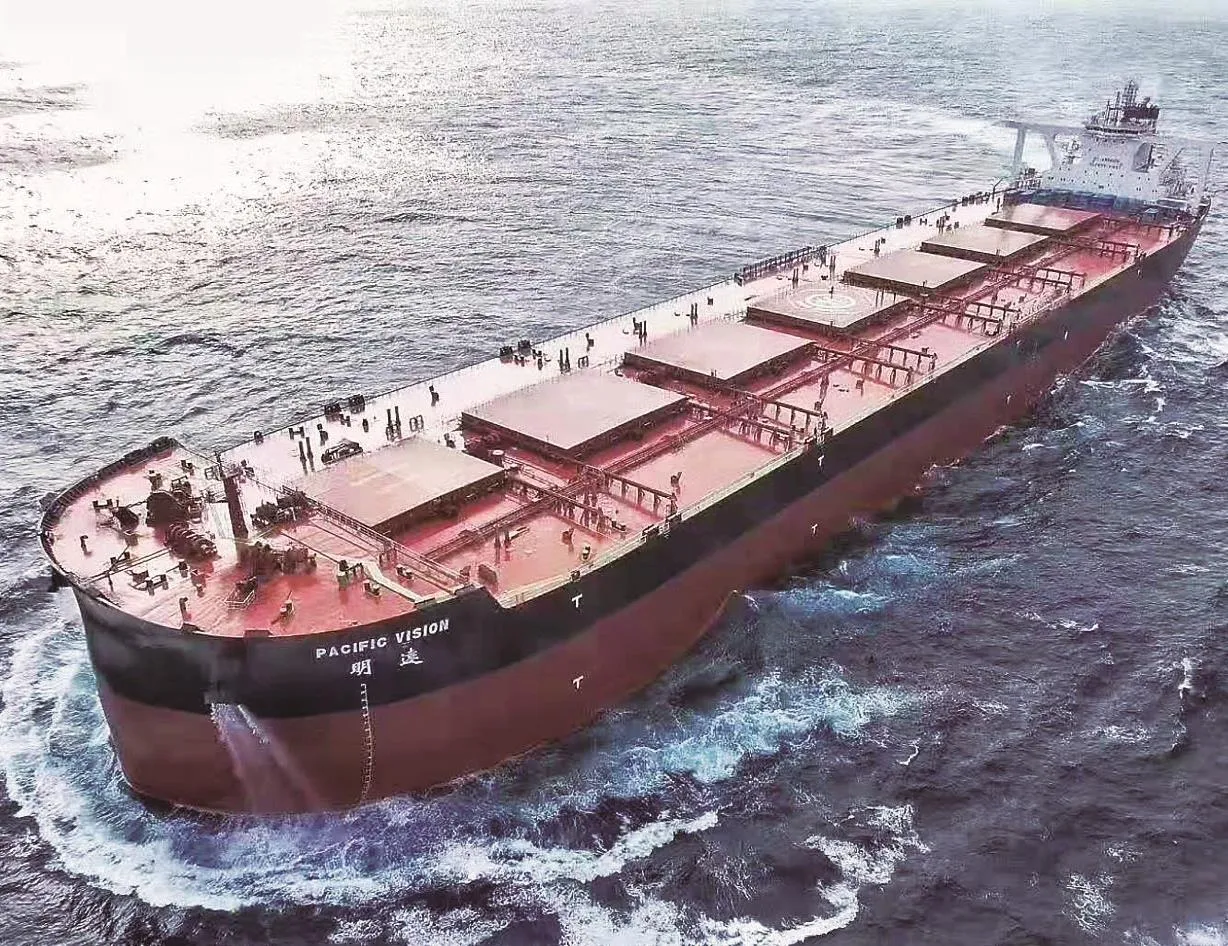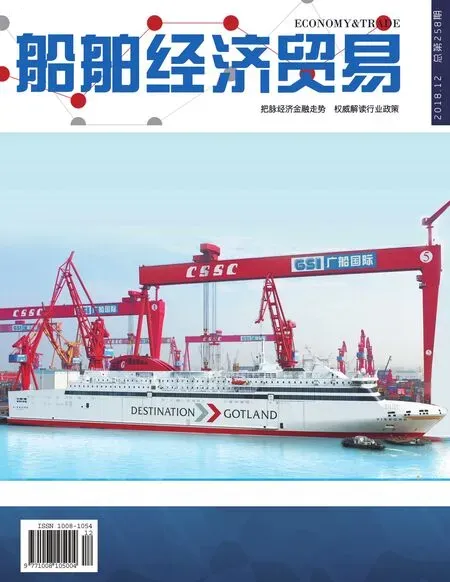Global First Smar t VLOC Sea Trial Succeeds
By He Baoxin and Qian Ping
On November 14, 2018, the world's first 400000 ton intelligent verylarge ore tanker (VLOC) successfully completed its trial voyage at Shanghai Waigaoqiao Shipbuilding Co., Ltd., a subsidiary of CSSC. With the careful organization of Waigaoqiao Shipbuilding,the intelligent ship project team overcame difficulties caused by bad sea conditions, cumbersome sea trials and many uncertain factors. After 10 days of sea trial, the established objectives were successfully achieved. The results of navigation test show that all functions of the intelligent system of the ship meet the requirements of the scientific research mission. Its results were unanimously recognized by the shipowner, CCS and DNV GL.
As the first demonstration ship of China's intelligent ship 1.0 R&D Project,this ship realizes five intelligent module functions -- auxiliary autopilot, energy efficiency management, equipment operation and maintenance, ship-shore integrated communication and cargo liquefaction monitoring by constructing the network platform and information platform serving the intelligent system.The ship obtained CCS i-ship (N,M,E,I)and DNV GL Smart Ship class notations,and other five intelligent module functions. The ship is the first intelligent ship certified by both classification societies and the first intelligent ship ever certified by DNV GL in the world.
“One Team, One Strategy, One Goal”
In recent years, IMO has vigorously promoted the implementation of the“E- Navigation” strategy. Korean,Japanese and European enterprises have one after another developed the concept of smart ship, launched related products and realized the receipt of orders, and formulated relevant standards. Smart ship research has become a “hotly contested spot” in the global shipbuilding industry.
In 2016, the Ministry of Industry and Information Technology set up the “Smart Ship 1.0 Project” to organize the top general institutes of the shipbuilding industry, intelligent system development units, shipbuilding groups, and colleges and universities to work together to carry out research on intelligent ships. CSSC is the organization implementer and important participant of the project. Waigaoqiao Shipbuilding, Shanghai Ship Design and Research Institute (SDARI) and China Shipbuilding Industry System Engineering Research Institute under CSSC, in collaboration with China Merchants Bureau Energy Transportation Co., Ltd., Beijing Highlander Digital Technology Co., Ltd., Shanghai Ship and Shipping Research Institute (SSSRI),CCS, Harbin Engineering University and other industry leading units, gave play to their respective advantages and fully promoted the “Smart Ship 1.0 Project”R&D.
In the implementation of the project,the project participants worked together to overcome difficulties in line with the“One Team, One Strategy, One Goal”objective.
With clear responsibility and definite division of labor,the R&D team centered around three major topics-- generic technology, key systems and demonstration application, fully cooperated, coordinated and collaborated,defined the overall goal of the project,namely building the unified network platform and the information platform,realizing the whole ship information collection, processing, storage and interaction; achieving on-board application of five intelligent function modules, including auxiliary autopilot,comprehensive energy efficiency management, equipment operation and maintenance, mineral liquefaction monitoring, and ship-shore integrated communication. The ship obtained CCS intelligent ship's additional marks i-Ship(N, M, E, I) as well as DNV GL Smart Ship ship notation.
During the implementation of the intelligent ship project, the Waigaoqiao Shipbuilding Design Department carried out fruitful work in promoting the integration design of the whole intelligent system and the ship, combing out a large number of intelligent system perceptual signal demand lists. The perceptual layout was optimized and more than 500 drawings were designed.Aiming at the problem of signal mismatch between domestic equipment and foreign equipment, Waigaoqiao Shipbuilding Design Department organized and carried out many signal testing and matching work in real ships and laboratories, and coordination of intelligent system mooring and navigation outline arrangement and intelligent equipment installation and so on. Due to the conceptual and cognitive information asymmetry between the intelligent system developers and shipbuilders,how to draw up an outline suitable for ship verification became a severe test for Waigaoqiao Shipbuilding and research units. After many discussions, Waigaoqiao Shipbuilding Design Department finally took the lead to implement the test outline that can guide production, paving the way for the overall promotion of the on-board combined adjusting and verification.

“One Ship, One Group of People, One Period of Feeling”
It can be said that the demonstration ship project is the crystallization of sincere cooperation between industry, university and research. Waigaoqiao Shipbuilding had to not only ensure promoting production according to the established large nodes, but also face the pressure of intelligent ship-side building during R&D in the whole shipbuilding process. Especially in the stage of mooring and commissioning, Waigaoqiao shipbuilders worked hard day and night to establish and perfect a set of intelligent shipbuilding supervision procedures.
From the initial stage of the research and development to the demonstration ship on-board joint adjustment, personnel of each unit of SSSRI Laboratory onshore integrated test carried out long-term high-intensity work. Especially in the later software alignment, Waigaoqiao Shipbuilding and SSSRI formed an intelligent system team, often working late into the night.

Highlander sent the company's vice president to lead an R&D team of nine members to participate in the ship trial voyage. They applied for the test item during the day, and at night modified the procedure for problems they found, and the navigation room became their research and development room.
The researchers responsible for ship-shore integrated communication in the System Engineering Institute solved problems one by one without fear of difficulties, thus ensuring the successful completion of the testing work.
The head of the ship's energy efficiency work at SSSRI failed to sail with the ship at the beginning of the trial due to work arrangement, but after completing the work, he boarded a tugboat in the early hours of November 7, and after six hours of sea bumps reached the anchorage. Only after taking a little rest, he started the software modification and application for inspection and training work.
The relevant personnel of CCS and DNV GL had been planning and guiding the operation at the commissioning site all the time. Although the intelligent ship is only a demonstration application of the intelligent ship 1.0, the design,construction and supporting system of the intelligent ship and information integration are at a high level. The completion of the ship can not only speed up the intelligent ship code independently compiled by China to the international level, but also promote the reform of the whole shipbuilding market and even the national information security. The director of DNV GL supervision, who participated in the sea trial, said that by participating in the project, they were deeply aware of the competitiveness of China's shipbuilding industry in the field of intelligent ships.Chinese equipment manufacturers are expanding from providing lower-end products to high-technology, high-valueadded products, and those products once monopolized by European, American and Japanese enterprises have been gradually replaced by China. At the same time,making the project a reality in such a short period of time fully reflects the excellent coordination contracting capacity of Chinese shipbuilding enterprises.
“Bulky Fellow” with“Big Wisdom”

On the basis of the “Da Zhi”,the intelligent ship has achieved a breakthrough in six aspects. First, the concept of “platform application” is first put forward and applied in a real ship. That is, the network information platform completes the acquisition,processing, and analysis of the whole ship's perceptual information,provides operation environment data to all smart systems, and solves a series of problems such as repeated acquisition of information from the whole ship,disunity of signal standard, lack of expansibility of ship system and so on.Second, it is the first time that it has the function of auxiliary collision avoidance decision in open water area, which can provide advice to the crew and help solve the problems affecting the safety of navigation, such as crew misoperation and missed operation, which will lay a technical foundation for the next step to realize the ship's independent collision avoidance. Third, the communication between ships is realized for the first time, which solves the problem of direct communication between ships at sea,and paves the way for the realization of collision avoidance in the future. The fourth is to realize the function of mineral liquefaction monitoring for the first time,by monitoring the liquefaction degree of minerals in cargo tanks, providing advice to the crew, solving the problems that the easy liquefaction minerals such as iron ore and nickel ore affect the stability of ships, and improving the navigation safety of ships. The fifth is to realize the function of lightweight transmission of integrated ship-shore communication,and to compress and encrypt the data and send it back to shore, which provides a reliable data source for the future construction of shoreline data center.Sixth, the intelligent ship symbols of CCS and DNV GL were obtained at the same time.

- 船舶经济贸易的其它文章
- 2018 Shiprepairing Industr y:Advancing in Wind and Rain,Growing in Change
- Fujian Shipbuilding: New Bright Spot in Production and Management in New Era Reappears
- Domestic Enterprises Have a Variety of Ways in Cruise Equipment Supply
- 需求不振行情整体低迷2018年11月中国沿海(散货)运输市场分析
- 供需基本面呈现总体向好态势2018年11月中国出口集装箱运输市场分析
- 成交基本稳定运价有升有降2018年11月世界油货运输市场分析

